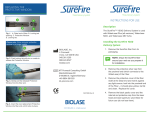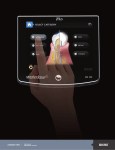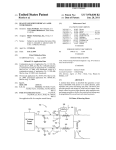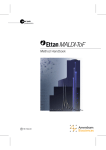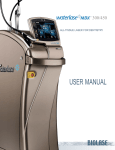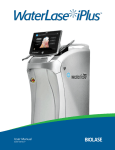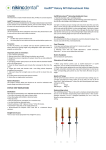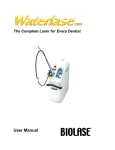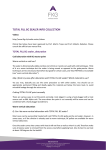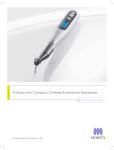Download Root Canal Therapy System
Transcript
Root Canal Therapy System Contents: Anterior kit: RFT2, 25mm Tip - 1 (EA) / RFT3, 21mm Tip - 1 (EA) Posterior kit: RFT2, 21mm Tip - 1 (EA) / RFT3, 17mm Tip - 1 (EA) Er, Cr: YSGG Waterlase MD™ for Complete Root Canal Therapy The Waterlase MD™ Er,Cr:YSGG system has numerous applications for cutting, removing, shaping and contouring hard and soft tissues including access preparation, cleaning and enlargement procedures related to endodontic therapy. Recently, these clinical indications have been expanded to include root canal disinfection after endodontic instrumentation. Following is a basic reference guide to procedural steps involved in performing complete laser root canal therapy including disinfection. Anterior Part No. 7200795 / Posterior Part No. 7200801 To reorder call Henry Schein at (800) 372-4346 and for information call Biolase at (800) 321-6717. STEP 1 Access Preparation Warnings & Precautions: Eyewear: Doctor, patient, assistant and all others inside the operatory must wear appropriate laser protective eyewear for the 2.78 µm wavelength (OD 4). All settings provided are for use with the MD Gold Handpiece. 1. Access is prepared using the MZ5 ZipTip™ (6mm). 2. Select settings listed in the table below. Angle the tip 30-45° to the long axis of the tooth to cut enamel effectively. Clinical Use: The Endolase RFT™ system is suited for straight and slightly curved canals. Before proceeding with any endodontic treatment, a careful review of the Waterlase MD™ User Manual (e.g., Section: Contraindications, Precautions and Warnings), proper clinical training and practice on extracted teeth is recommended. Use caution when using tips through narrow and curved passages at all times. Forcing a tip through a narrow curved or obstructed canal could results in tip breakage and/or perforation. Activate the laser only when moving the tip upward coronally. 3. Lower power setting or defocus the beam to cut through dentin. 4. Use the MZ5 for removal of pulp. Select “pulp removal” settings (see table below) to remove vital/non-vital pulpal tissue. Settings Figure 1 STEP 2 Conventional Instrumentation Step 1 Tip Access MZ5 Power Pulse Rate Step 1 Tip Power Pulse Rate Pulp Removal MZ5 .75-1.0 W 20 Hz 4.5 - 5.5 W 15/20 Hz Air Water Mode 60% 30% H Air Water Mode 2-11% 7-11% H STEP 3 Cleaning & Enlargement RFT2 1. Estimate the working length following standard protocol. 1. Use the RFT2 to perform apical and partial coronal 2/3 cleaning. 2. Start instrumentation using K-files or a combination of K-files and rotary files to enlarge and shape the canal. 2. Place tip into handpiece and select settings from the table below. 3. Apical instrumentation is performed to at least a size 30 K-file to allow the RFT2 tip to reach the apex. 3. Fill canal with sterile solution. 4. Insert RFT2 (1) mm short of the apex. (Use the rubber slider on the tip as a depth indicator.) 5. Activate laser and start moving the tip coronally at approximately 1 mm/s. Maintain tip in contact with the side surface of the canal wall during the entire apical to coronal pass. Figure 2 6. Repeat steps 4 and 5 one or two more times to ensure that the entire inner-canal has been cleaned (see Figure 6). Figure 3 RFT3 7. Use the RFT3 to perform final cleaning of the coronal 2/3. 8. Place tip into the handpiece and select settings from the table below. 9. Fill canal with sterile solution. 10. Insert RFT3 at the junction between apical and middle third. 11. Activate laser and start moving the tip coronally at approximately 1 mm/s. Use the same technique as step 5. 12. Re-insert tip and perform an additional pass over the same area. Figure 5 – Hydrophotonic effect 13. Repeat Steps 10 through 12 three more times to ensure cleaning of the remaining coronal 2/3. Settings Figure 4 Step 3 Tip Power Pulse Rate Air Water Mode Cleaning & Enlargement RFT2 1.25 W 50 Hz 24% 34% H Step 3 Tip Power Pulse Rate Air Water Mode Cleaning & Enlargement RFT3 1.25 W 50 Hz 24% 34% H Figure 6 – Tip position during different passes STEP 4 Disinfection RFT2 1. Use the RFT2 to perform disinfection of the apical and partial coronal 2/3. 2. Place tip into handpiece and select settings from the table below. This procedure is performed with 10% air flow and no water. 3. Insert RFT2 (1) mm short of the apex. 4. Activate laser and start moving the tip coronally, at approximately 1 mm/s. Maintain tip in contact with the side surface of the canal wall during the entire pass. Use a brushing technique to deliver YSGG laser energy to the surface. Figure 8 5. Re-insert tip immediately and perform an additional pass over the same area. Figure 7 6. Repeat steps 3 through 5, two to three more times to ensure disinfection of apical and partial coronal 2/3. Figure 9 RFT3 7. Use the RFT3 to perform final disinfection of the coronal 2/3. 8. Place tip into handpiece and select settings from the table below. Use 10% air flow as before (see step 2). 9. Insert RFT3 at the junction between apical and middle third. 10. Activate laser and start moving the tip coronally, at approximately 1 mm/s. Use the same techniques as step 4 (disinfection). 11. Re-insert tip immediately and perform an additional pass over the same area. 12. Repeat steps 9 through 11, three to four more times to ensure disinfection of the remaining coronal 2/3. Settings Step 4 Tip Power Pulse Rate Air Water Mode Disinfection RFT2 .75 W 20 Hz 10% Off H Step 4 Tip Power Pulse Rate Air Water Mode Disinfection RFT3 .75 W 20 Hz 10% Off H Figure 10 Use any of your preferred techniques and materials to fill the canal and restore the tooth. Calibration Factor Single Use Non-Sterile Tips Included 1. Use only as specified in this guide. 2. Tip may break when excessive force is applied. 3. Dispose in sharps container after single use. RFT2 Obturation & Restoration Placement RFT3 RFT2 RFT3 Tip Diameter, μm 275 415 Tip Length, mm 25, 21 21, 17 Max Power of Operation [Watt] 4.0 4.0 Calibration Factor * 0.55 0.85 * Laser Power recommended with procedural steps are values on the display. The actual power output can be calculated by multiplying that value by the Calibration Factor for each tip. Disclaimer Only licensed professionals who have successfully completed training should use this instrument. Always start treatment at the lowest power setting and increase as required. Closely observe the clinical effects and use your judgment to make appropriate adjustments to compensate for varying tissue compositions, density and thickness. Use your clinical judgment to decide the clinical protocol and whether any additional laser or conventional instrumentation is required. It is important to note that sound principles of endodontic treatment have not been affected by using this technique. Protocols that constitute correct endodontic treatment such as rubber dam isolation, irrigation, drying and obturation, etc. remain within the scope of the operator’s clinical judgment and experience. U.S. Patent Numbers: 4,940,411; 5,116,227; 5,151,029; 5,232,367; 5,257,935; 5,267,856; 5,324,200; 5,342,198. Other U.S. and Int’l Patents Granted and Pending 4 Cromwell • Irvine CA 92618 • 800.321.6717 • biolase.com 5201077 Rev. A (03/31/08)


